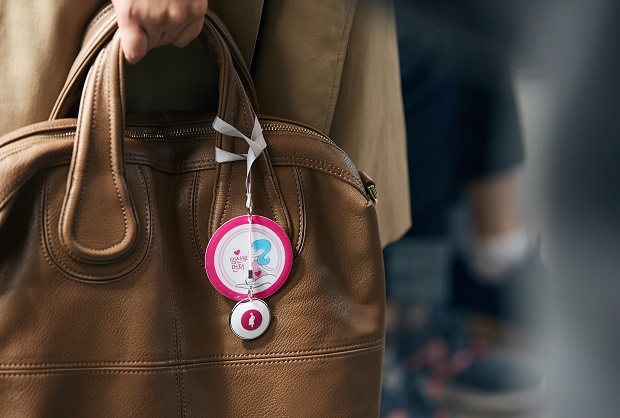
In this Wednesday, April 6, 2016 photo provided by Busan Metropolitan City, a woman holds a bag with a small, round device called a beacon, the smaller one, written with “Pregnant passengers first” and equipped with a wireless sensor, in a subway train in Busan, South Korea. South Korea’s second-largest city of Busan is testing a wireless technology it hopes can alleviate such problems and perhaps help address one of the biggest challenges facing the Asian country: a stubbornly low birthrate. The beacon activates a pink light attached to another sensor installed on a metal bar next to special priority seats usually at the end of subway cars. AP
BUSAN, South Korea — Before they show a baby bump, what some pregnant women in South Korea can expect when expecting is accusing glares when they take subway seats meant for pregnant, disabled or elderly passengers.
One South Korean city is testing a wireless technology it hopes can alleviate such problems and perhaps help address one of the biggest challenges facing the Asian country: a stubbornly low birthrate.
In April, the southeastern port of Busan, South Korea’s second-largest city, began testing a small, round device called a beacon. Equipped with a wireless sensor, it activates a pink light attached to another sensor installed on a metal bar next to special priority seats, usually at the end of subway cars. The idea is to alert all nearby that the person carrying the beacon has a baby on the way.
The “Pink Light Campaign” can help non-pregnant passengers who might be occupying a seat designated for riders who are expecting to yield the spot without having to guess, is she or isn’t she? In theory, pregnant women also can claim a seat without having to ask.
“It is hard to tell if a woman is pregnant, and give up a seat, when she doesn’t have a baby bump,” said Lee Gyeong-eon, a 23-year-old college student who frequently travels by subway.
Other South Korean cities also are trying to make travel by public transportation friendlier to pregnant women. Seoul, the capital, has installed bright pink seats designated for women who are expecting.
With one of the lowest birthrates in the world, South Korea is eager to encourage larger families. South Korean women had 1.21 children on average in 2014. The average for the wealthy nations belonging to the Organization of Economic Cooperation and Development was 1.68.
The Busan experiment is part of the trend toward the “Internet of Things,” which uses wireless technology in products not usually associated with internet connectivity, such as toothbrushes or socks.
“I have felt a bit uncomfortable about getting a seat or claiming a seat reserved for pregnant women,” said Ock Si-yoon, a 33-year-old who is expecting a baby. “Early on, there is a risk of miscarriage, so I’m a bit uneasy about using public transportation, since subways or busses shake a lot and it is difficult to get someone to yield a seat for me.”
“These days, people are usually looking at their phones and they are not really aware that a seat is reserved for pregnant women,” she said. “But now, with the ‘Pink Light Campaign,’ it is easy for people to notice when the sensor blinks.”
For now, Busan’s trial of the technology is limited to a few sections of the city’s transit system. But the city plans to expand it to more subway lines and to buses.
“Consideration for pregnant women should prevail and they should be able to use public transportation more easily and conveniently with this policy,” said Suh Byung-soo, Busan’s mayor.
“Women should be able to use city facilities easily even when they are expecting,” he said.
RELATED STORIES
Portable ultrasound device addresses healthcare for moms in rural areas
Overdose of folate and vitamin B12 during pregnancy may lead to autism—study